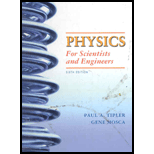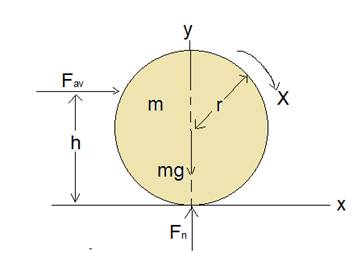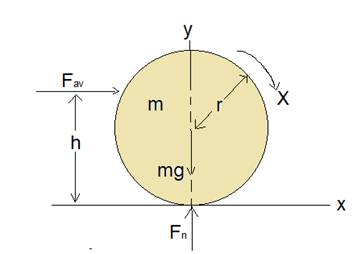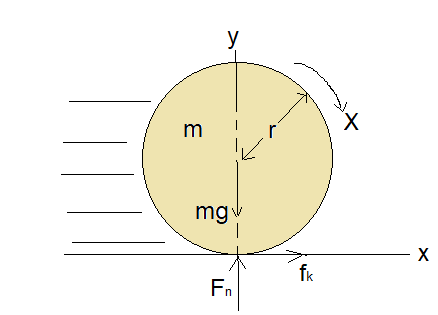
Concept explainers
(a)
The speed of the ball just after impact.
(a)
Answer to Problem 104P
Explanation of Solution
Given:
Mass of a uniform solid ball =
Radius of the ball =
The height above the horizontal surface at which the force is applied on the ball,
During the impact, the force (F) increases from
Therefore, average force,
Formula used:
Applying impulse-momentum theorem to the ball,
Where
Calculation:

FIGURE:
Substituting numerical values in equation
Conclusion:
The speed of the ball just after impact is
(b)
The angular speed of the ball after impact.
(b)
Answer to Problem 104P
Explanation of Solution
Given:
Mass of a uniform solid ball =
Radius of the ball =
The height above the horizontal surface at which the force is applied on the ball,
During the impact, the force (F) increases from
Therefore, average force,
Formula used:
Applying Newton’s second law in rotational form to ball,
Where,
Moment of inertia with respect to an axis through the center of mass of the ball is
Substituting this in equation
From equation
Substituting the expression for
Calculation:

FIGURE: 2
Substituting the numerical values in equation
Conclusion:
The angular speed of the ball after impact is
(c)
The speed of the ball when it begins to roll without slipping.
(c)
Answer to Problem 104P
Explanation of Solution
Given:
Mass of a uniform solid ball =
Radius of the ball =
The height above the horizontal surface at which the force is applied on the ball,
During the impact, the force (F) increases from
Therefore, average force,
Coefficient of kinetic friction,
Formula used:
Constant acceleration equation that relates the speed of the ball to the acceleration and time,
Where,
Referring to the force diagram shown in figure 3, applying Newton’s second law to the ball,
And
Where,
But,
Where,
From equation
Substituting this in equation
Substituting the expression for
Substituting
From equation
Substituting for
Now let us write constant-acceleration equation that connects angular speed of the ball to the angular acceleration and time,
When the ball rolls without slipping
From equation
Hence,
Now equating the expressions
On rearranging,
Calculation:

FIGURE:3
Substituting the numerical values in equation
Substituting the numerical values in equation
Conclusion:
The speed of the ball when it begins to roll without slipping is
(d)
The distance travelled by the ball along the surface before it begins to roll without slipping.
(d)
Answer to Problem 104P
Explanation of Solution
Given: Coefficient of kinetic friction,
Formula used:
The distance travelled by the ball in time
Since,
Where,
Calculation:

FIGURE: 4
From the part
Substituting the numerical values in equation
Conclusion:
The distance travelled by the ball along the surface before it begins to roll without slipping is
Want to see more full solutions like this?
Chapter 9 Solutions
PHYSICS F/SCI.+ENGRS.,STAND.-W/ACCESS
- Suppose that a particular heart defibrillator uses a 1.5 x 10-5 Farad capacitor. If it is charged up to a voltage of 7300 volts, how much energy is stored in the capacitor? Give your answer as the number of Joules.arrow_forwardThe voltage difference across an 8.3 nanometer thick cell membrane is 6.5 x 10-5volts. What is the magnitude of the electric field inside this cell membrane? (Assume the field is uniform, and give your answer as the number of Volts per meter... which is the same as the number of Newtons per Coulomb.)arrow_forwardThree identical capacitors are connected in parallel. When this parallel assembly of capacitors is connected to a 12 volt battery, a total of 3.1 x 10-5 coulombs flows through the battery. What is the capacitance of one individual capacitor? (Give your answer as the number of Farads.)arrow_forward
- Suppose you construct your own capacitor by placing two parallel plates at a distance 0.27 meters apart. The plates each have a surface area of 0.64 square meters. What is the capacitance of this setup? (Give your answer as the number of Farads.)arrow_forwardDraw a diagram with the new arrows. No they do not point all towards the center.arrow_forwardExample In Canada, the Earth has B = 0.5 mŢ, pointing north, 70.0° below the horizontal. a) Find the magnetic force on an oxygen ion (O2) moving due east at 250 m/s b) Compare the |FB| to |FE| due to Earth's fair- weather electric field (150 V/m downward).arrow_forward
- Four charges, qa, qb, qa, and qd are fixed at the corners of a square. A charge q that is free to move located at the exact center of the square. Classify the scenarios described according to the force that would be exerted on the center charge q. Assume in each case that q is a positive charge. Do not assume that the fixed charges have equal magnitudes unless the scenario defines such an equality. qa Яс q %b Force is zero Force is to the left Force is to the right Force is undeterminedarrow_forwardCharge qi = -q is located at position (0, d). Charge q = −2q₁ is located at position (d,0). Charge q3 = located at position (2d, 2d). 5qi is y Determine the net electric field Ĕ net at the origin. Enter your expression using ij unit vector notation in terms of the given quantities, the permittivity of free space €0, and exact rational and irrational numbers. d 9₁ d TH net = 92 d d Xarrow_forwardsolve pleasearrow_forward
- = = R4 R5 = 12.5 Q. A - In the circuit shown, R₁ = R₂ = R 3 voltmeter measures the potential difference across the battery. When the switch is in position 1, the voltmeter measures V₁ = 13.8 V. When the switch is in position 2, the voltmeter measures V2 = 13.4 V. What is the emf ☐ of the battery? 14.93 = What is the battery's internal resistance r? r = V CH Ω R₁₂ V S R₁ 02 2 R₁ 4 R3 R 5arrow_forwardConsider the arrangement of charges shown in the figure. Four charges of equal magnitude Q but varying sign are placed at the corners of a square as indicated. A positive charge q is placed in the center. What is the direction of the net force, if any, on the center charge? Indicate your answer by placing the appropriate label in the first box. Then, suppose that the charge q were to be displaced slightly from the center position. On the figure, label each box with the arrow that best indicates the direction of the net force that would act on q if it were moved to that location. Net Force Answer Bank no force ↑ +2 0 -Q -Q +Qarrow_forwardDon't use ai to answer I will report you answerarrow_forward
 Glencoe Physics: Principles and Problems, Student...PhysicsISBN:9780078807213Author:Paul W. ZitzewitzPublisher:Glencoe/McGraw-Hill
Glencoe Physics: Principles and Problems, Student...PhysicsISBN:9780078807213Author:Paul W. ZitzewitzPublisher:Glencoe/McGraw-Hill Physics for Scientists and Engineers: Foundations...PhysicsISBN:9781133939146Author:Katz, Debora M.Publisher:Cengage Learning
Physics for Scientists and Engineers: Foundations...PhysicsISBN:9781133939146Author:Katz, Debora M.Publisher:Cengage Learning Principles of Physics: A Calculus-Based TextPhysicsISBN:9781133104261Author:Raymond A. Serway, John W. JewettPublisher:Cengage Learning
Principles of Physics: A Calculus-Based TextPhysicsISBN:9781133104261Author:Raymond A. Serway, John W. JewettPublisher:Cengage Learning University Physics Volume 1PhysicsISBN:9781938168277Author:William Moebs, Samuel J. Ling, Jeff SannyPublisher:OpenStax - Rice University
University Physics Volume 1PhysicsISBN:9781938168277Author:William Moebs, Samuel J. Ling, Jeff SannyPublisher:OpenStax - Rice University Physics for Scientists and Engineers with Modern ...PhysicsISBN:9781337553292Author:Raymond A. Serway, John W. JewettPublisher:Cengage Learning
Physics for Scientists and Engineers with Modern ...PhysicsISBN:9781337553292Author:Raymond A. Serway, John W. JewettPublisher:Cengage Learning College PhysicsPhysicsISBN:9781938168000Author:Paul Peter Urone, Roger HinrichsPublisher:OpenStax College
College PhysicsPhysicsISBN:9781938168000Author:Paul Peter Urone, Roger HinrichsPublisher:OpenStax College





